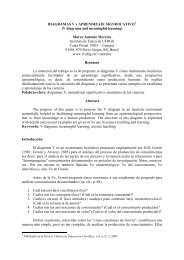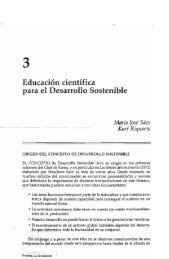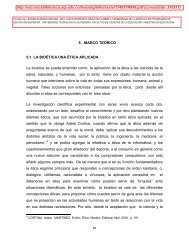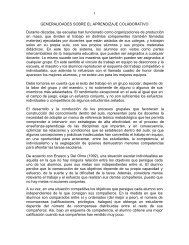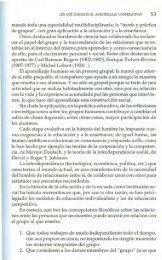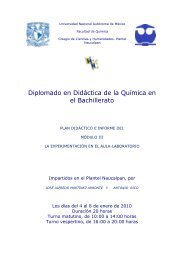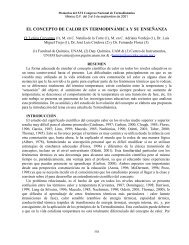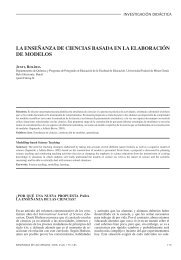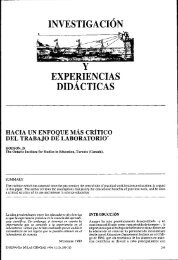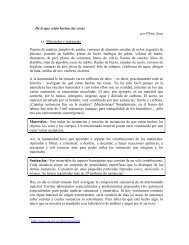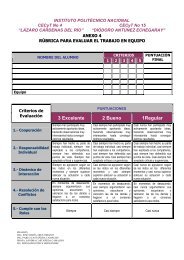Educación Química, vol. 08, núm. 3 - Coordinación de Actualización ...
Educación Química, vol. 08, núm. 3 - Coordinación de Actualización ...
Educación Química, vol. 08, núm. 3 - Coordinación de Actualización ...
You also want an ePaper? Increase the reach of your titles
YUMPU automatically turns print PDFs into web optimized ePapers that Google loves.
PROFESORES AL DÍA<br />
Figure 1. Discrete one-dimensional lattice.<br />
Balances of probability<br />
To study the balance of probability, we take time as a<br />
continuous variable. One could take it as a discrete one, but<br />
the analysis in such case gets messier. Furthermore, in the<br />
limit of our interest both balances are entirely equivalent. Let<br />
the time for a transition be the infinitesimal quantity dt. The<br />
probability of a transition between adjacent sites is the product<br />
a dt<br />
Figure 2 shows any three adjacent sites of the lattice.<br />
Notice that particles can never be located in between sites of<br />
the lattice. The question one wishes to answer is what the<br />
probability of finding a particle on site y at a time t + dt is.<br />
We <strong>de</strong>note such probability by P(y, t + dt). Since the time for<br />
a transition is dt, the balance of probability looks like<br />
P (y, t + dt ) =<br />
= a dt P (y + ∆y, t ) + a dt P (y − ∆y,t ) + (1 − 2a dt )P(y, t) (1)<br />
The first two terms on the right hand si<strong>de</strong> of equation (1)<br />
come from the respective forward and backward transitions<br />
from sites y − ∆y and y + ∆y. The last term on the right is the<br />
probability for the particle of staying on site y. In other words,<br />
it is a conservation equation.<br />
Now we go to the limit at which the number of sites of<br />
the discrete lattice, N, increases to infinity. Consequently, the<br />
space between site s, ∆y, <strong>de</strong>creases to zero and the transition<br />
rates, a, increase to infinity.<br />
Figure 2. Any three adjacent sites of the lattice. The a’s represent transition<br />
rates.<br />
The Limit<br />
Since a → ∞ and ∆ y → 0 it is reasonable to expect that their<br />
product remains constant, in the limit. Let us <strong>de</strong>note the limit of<br />
a (∆y) 2 by D. So arranging equation (1) one gets<br />
lim<br />
N,a,v → ∞;∆y, dt → 0<br />
lim<br />
N,a,v → ∞;∆y,dt → 0<br />
P (y, t + dt ) − P (y, t )<br />
dt<br />
=<br />
a (∆y) 2 [P (y + ∆y,t ) + P (y − ∆y,t ) − 2P (y,t )]<br />
(∆y) 2 (2)<br />
This is an equation in finite differences. One should<br />
remember that, in the limit of infinitesimally small differences,<br />
first differences become first <strong>de</strong>rivatives, second or<strong>de</strong>r<br />
differences become second <strong>de</strong>rivatives, and so on. Therefore,<br />
the final limiting equation is<br />
∂ P( y, t)<br />
∂<br />
= D<br />
∂ t<br />
2<br />
P( y, t)<br />
2<br />
∂ y<br />
Equation (3) is Fick’s second law of diffusion (Noggle,<br />
1989), a partial differential equation. Solving (3) is out of the<br />
scope of this paper; it can be found to be<br />
P( y, t) =<br />
2<br />
1 ⎛ − y ⎞<br />
exp⎜<br />
⎟<br />
4π<br />
Dt ⎝ 4Dt<br />
⎠<br />
by using Fourier transform techniques (McQuarrie, 1976).<br />
Instead of learning how to solve (3), and similar equations,<br />
we use an alternative method which still allow to grab<br />
good physical chemical insight, the method of moments<br />
(Aris, 1956).<br />
Temporal variation of the Moments.<br />
The Physical Connection<br />
It is shown that the link between the equations above with<br />
the physical world is given by the moments of the function<br />
P(y, t)<br />
n<br />
〈 y 〉 ≡<br />
∞<br />
∫<br />
−∞<br />
n<br />
y P( y, t)<br />
dy<br />
The function P(y, t) in Eq. (5) is what statisticians call a<br />
<strong>de</strong>nsity function of probability (Spiegel, 1975). It is a function<br />
normalized by the condition<br />
∞<br />
∫ P( y, t) dy = 1<br />
−∞<br />
which is nothing but a conservation condition. Physically,<br />
Eq. (6) implies that, at any time, the sum of all the contributions<br />
to the probability of finding particles is equal to the total<br />
normalized probability.<br />
Let us visualize experimentally all what has been said<br />
(3)<br />
(4)<br />
(5)<br />
(6)<br />
Julio <strong>de</strong> 1997 125





